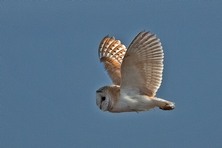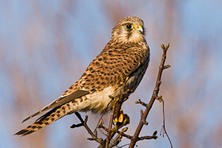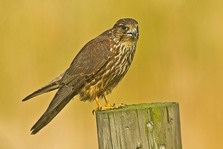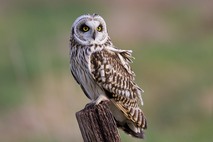

Biodiversity
Action
Plan
Birds of Prey hunt for and feed on small mammals, birds and carrion, and also larger insects and earthworms when prey is in short supply. Birds of prey can be found in Barnsley in a range of habitats.
Barn Owl and Kestrel are farmland bird indicator species; Merlin and Short-eared Owl are species for which the South Pennine Moors have been designated as a Special Protection Area (SPA).
Barn Owl can be seen hunting rough grassland for voles and other small mammals, at dusk or dawn.
The pale Barn Owl has a heart-shaped face and a shrieking call; it leaves dark pellets at roosts.
Barn Owl is a scarce breeding bird in Barnsley with up to 35 breeding pairs, mainly in lowland areas east of the M1.
Conservation measures
- Maintain prey-rich rough grassland
- Provide nest boxes in suitable locations.
- Mitigation in barn conversions
Associated Habitats
- Rough lowland grassland
- Post-industrial land
- Field edges and embankments
Barn Owls nest and roost in tree cavities, farm buildings, and in nest boxes.
They pair in February with eggs laid in April / May. Young hatch in June and fledge in August.
Declines result from reduced small mammal numbers, loss of rough grassland and nest sites, road deaths, severe winters and the impact of pesticides.
Barn Owl
BoCC5 Green List
Schedule 1 protection W&C Act
Kestrel, reddish-brown, with long wings and tail, can be seen hovering, over roadside verges, hunting for prey.
Kestrels feed mainly on voles and other small mammals, small birds, insects and earthworms.
In Barnsley up to 200 breeding pairs, are found in areas where there is rough grassland.
Conservation measures
- Maintain prey-rich rough grassland
- Provide nest boxes in suitable locations.
Associated Habitats
- Rough lowland grassland
- Post-industrial land
- Field edges and embankments
- Road verges
Kestrels nest in holes in buildings, old crow nests and nest boxes.
4 – 6 eggs take about 30 days to hatch, with the young flying some 30 days later.
Declines result from reduced small mammal numbers with fewer areas of rough grassland as well as loss of nest sites and the impact of pesticides.
Kestrel
BoCC5 Amber List
General protection W&C Act
Other birds of prey
Sched. 1 BoCC Amber:
Marsh Harrier
Sched. 1, BoCC Green:
Goshawk, Hobby, Peregrine
BoCC Amber:
Tawny Owl, Sparrowhawk
BoCC Green:
Buzzard, Long-eared Owl,
[Little Owl introduced]


Birds of Prey
Merlin, our smallest bird of prey, is about the size of a blackbird, with blunt tail and compact, pointed wings.
Merlin feed on meadow pipits and other small birds, chasing them in flight, over wide areas.
There are probably only 1-2 breeding pairs on the moors within the Barnsley boundary.
Conservation measures
- Retain mature heather in breeding areas
- Control timing, frequency and location of heather burning relative to breeding sites
- Avoid disturbance in breeding season by restricting access to breeding sites
Associated Habitats
- Upland heathland
Merlin nest in moorland heather using a shallow scrape with territories used year to year by generations of birds.
They leave upland breeding areas from August to October and return in April and May.
Pesticides, habitat loss due to over-grazing, reduced small bird numbers and disturbance are factors in their decline.
Merlin
BoCC5 Red List [IUCN2 NT] SPA
Schedule 1 protection W&C Act

Conservation
- Maintain large areas of habitat that support small mammals.
- Protect Short-eared Owls in their breeding and foraging areas from disturbance.
Associated Habitats
- Mixed rough grasslands and heathland moors
Short-eared Owls breed from March to July with a second brood if prey is abundant.
Changes in upland land use and management and predator densities are likely to impact on Short-eared Owl populations.
Short-eared Owls often hunt in daytime for small mammals.
There is a small population of one or two pairs breeding on the western Barnsley moors.
They nest on the ground in scraped-out hollows lined with grass and downy feathers.
Short-eared Owl
BoCC5 Amber List SPA
Schedule 1 W&C Act
